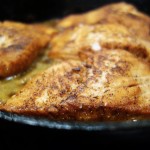If bell peppers, onions and celery are the “holy trinity” of South Louisiana food, then butter, heavy spice and a cast-iron skillet are the cuisine’s patron saints. After all, only a blessing from those patron saints could help a fancy fish from the great white north find favor in the eyes and stomachs of the people of South Louisiana.
But what exactly is blacked fish anyway? In the 1980s, Paul Prudhomme popularized blackened fish in an effort to market “Cajun” cooking to the rest of the country and the world. It worked, he was wildly successful. But there was a problem – blackened fish was about as Cajun as those bourbon chicken nuggets you find in the food court at the mall. That is to say, it wasn’t Cajun at all and was entirely Prudhomme’s invention.
But here’s the thing – Cajun roots or not, blackened fish is easy to make and just plain good. So we’ve adopted it and added a few twists of our own.
John Jones’ recipe uses salmon. That’s right, salmon. No, we don’t have salmon swimming upstream in our bayous or schooling in our 85 degree Gulf waters. There’s nothing cajun about salmon – except that it’s really good and we like good food.
In fact, John and his wife Ryn love it so much, they make it a Friday tradition in their South Baton Rouge home. If you’re lucky, they’ll invite you for an evening of good wine, great fish and even better company.

-
Ingredients Section
4 Salmon Filets (If you’re in Baton Rouge – try Maxwell’s Market. Our fish was literally still moving before the filets were cut).
Paul Prudhomme’s Blackened Redfish Magic Seasoning
Two Sticks of butter
Chopped Italian flat leaf parsley for color.

John’s ingredients are simple enough – clarified butter, Paul Prudhomme’s signature blackening spice, and salmon. The cast-iron skillet isn’t an ingredient, but it’s not optional either. Nothing retains heat like cast iron, and heat is as key to this recipe as the fish or the spice.
To begin, John uses a simple method to clarify the butter. He places two sticks of unsalted butter in a pyrex measuring cup and melts them in the microwave. After melting, he waits 10 minutes or so until the milk solids (fat) separate.
This is a good time to open a bottle of wine and turn a little music on. At John and Ryn’s house, they choose to listen to teenage pop music (they have two teenage daughters). After all, nothing says blackened salmon like a Fun. remix (Fun. is a band, in case you didn’t know).
After 10 minutes or so, John simply pours off the yellow clarified butter. But, unlike almost every recipe you’ve seen for clarified butter – John doesn’t throw out the milk solids – he saves them in a small pan for a sauce he’ll make later.

After the butter is clarified, it’s a good idea to check your salmon for any small bones. In South Louisiana, we use rusty needle nose pliers to do the job, but then again – that’s just us.
While the butter is separating, John likes to prepare a subtle caper sauce for the dish. The fish can stand on its own without it, but the sauce made with capers, butter and the extra milk solids simmered for 10-15 minutes takes the dish to an entirely different level.

As the sauce cooks down, the most important step in the process begins. Start by placing a large black iron skillet on high heat. Then, walk away. Don’t turn the heat down, don’t move the pan. Just turn on your exhaust fan and walk away (John actually removes the filter because it tends to hold on to the smell long after cooking). After about 8 minutes, the pan should be white hot and smoking like a barbecue pit.
The rest of the process is painfully easy: Dip your salmon into the butter, covering all sides. Then cover in blackening spice (the more you add the spicier it will be) and put flesh side down in the pan. Then wait exactly 3 minutes before turning and cooking for an additional 3 minutes or until the salmon is a perfect medium to medium rare.


Be warned, only with incredibly high heat does this process work well. The heat immediately sears the spices to the fish and creates a crust of cajun flavor. If the pan isn’t hot enough (i.e., just shy of the temperature of the sun), the spices will simply dissipate into the butter. It will still be good – just not as good.
Finally, cover with caper sauce, serve with a nice vegetable side and some rice and enjoy the blessing the patron saints of Louisiana food can provide – with a twist from the frigid waters of the Pacific Northwest. Together at last…



